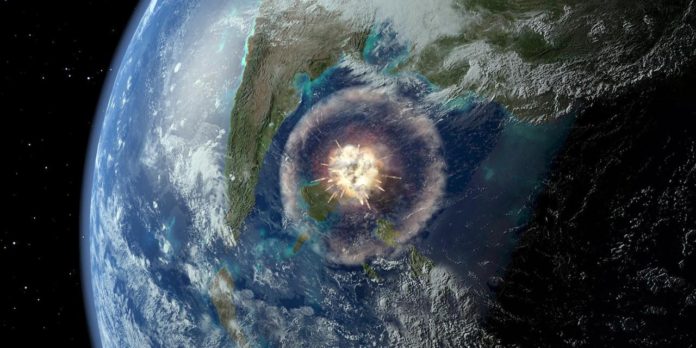Around 66 million years ago the Chicxulub asteroid hit the Earth with such force that it wiped out around 75 percent of all plant and animal species, including the entire species of dinosaurs that were alive at the time. It happened near what we now call the Yucatan peninsula in the Gulf of Mexico. Researchers are now discovering that the impact had a much more climate-altering effect than first realized.
The new research involves making a more accurate estimate of just how much sulfur and carbon dioxide gas were pumped into our planet’s atmosphere following the impact. Authors of the study are now suggesting that the levels of sulfur emitted at the time may have been as much as three times more than we assumed. This means it was probably much colder too.
Its long been thought that the impact played a key role in the extinction event of the Cretaceous-Paleogene era, and this study fully supports that theory. “Many climate models can’t currently capture all of the consequences of the Chicxulub impact due to uncertainty in how much gas was initially released,” said Joanna Morgan, co-author of the study and a geologist at Imperial College London. “We wanted to revisit this significant event and refine our collision model to better capture its immediate effects on the atmosphere.”
The results of the study will hopefully give researchers a clearer picture as to how the Earth’s climate changed so rapidly following the asteroid impact. “The key finding of the study is that they get a larger amount of sulfur and a smaller amount of carbon dioxide ejected than in other studies,” said Georg Feulner, a climate scientist at the Postdam Institute for Climate Impact Research in Germany. “These improved estimates have big implications for the climatic consequences of the impact, which could have been even more dramatic than what previous studies have found.”
When the impact happened all those million years ago, it threw masses of sulfur, dust, and carbon dioxide into the atmosphere. The sulfur and dust merged to form a reflective cloud that kept out sunlight, reducing the Earth’s temperature dramatically as a result. Using a computer code that simulates the pressure of shock waves emitted by the impact, the researchers were able to estimate how much gas was released in various impact scenarios. What they discovered was that around 325 gigatons of sulfur and 425 gigatons of carbon dioxide were released into the atmosphere at the time of the asteroid collision.
The new study had a much more accurate way than previous methods of determining the levels of gas in the atmosphere. Here, the researchers only included gases that were ejected upwards at a rate of 1 kilometer per second minimum. Those that ejected at slower speeds had no impact on climate change, says Natalia Artemieva, co-author of the study and a senior scientist at the Planetary Science Institute in Tucson, Arizona. The new study also went by updated estimates of the impact’s angle (60 degrees opposed to 90 degrees). With it being at this angle, much more sulfur was shown to be ejected into the atmosphere. As well as gaining a deeper insight into the Chicxulub impact, the new method enables researchers to apply it to other large impacts to determine the amount of gas released there too.
More News to Read

